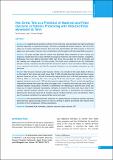Please use this identifier to cite or link to this item:
https://hdl.handle.net/20.500.14356/1000| Title: | Non Stress Test as a Predictor of Maternal and Fetal Outcome in Patients Presenting with Reduced Fetal Movement at Term |
| Authors: | Joshi, Sarita Kumari Dangal, Ganesh |
| Citation: | oshiS. K., & DangalG. (2022). Non Stress Test as a Predictor of Maternal and Fetal Outcome in Patients Presenting with Reduced Fetal Movement at Term. Journal of Nepal Health Research Council, 20(01), 21-25. https://doi.org/10.33314/jnhrc.v20i01.3628 |
| Issue Date: | 2022 |
| Publisher: | Nepal Health Research Council |
| Article Type: | Original Article |
| Keywords: | Decreased fetal movement Maternal outcome Fetal outcome NST |
| Series/Report no.: | Jan-March, 2022;3628 |
| Abstract: | Abstract Background: Establishing the predictive utility of Non stress test could be helpful to improve perinatal outcome especially in countries like Nepal, with heavy workload and limited resources. The aim of the study was to assess association between Non stress test abnormalities and fetal outcome in terms of Apgar score and newborn intensive care unit admission rate for patient with decreased fetal movement. Methods: The study included total 54 women with decreased fetal movement at term without any pregnancy complication not in labor admitted to paropakar maternity and women's hospital, Thapathali, Kathmandu from June 2020 to December 2020. Non stress test was done for 20 to 40 minutes and the readings were categorized in to three groups. The results were compared to see the relationship between normal, suspicious and abnormal Non stress test result in terms of mode of delivery, Apgar score, neonatal resuscitation and need for neonatal intensive care unit newborn intensive care unit admission. Results: Total 54 cases remained under inclusion criteria were included in this study. Mode of delivery on the basis of Non stress test result shows that 31.48% with abnormal Non stress test had a Lower segment Caesarian section, 1.8% had instrumental vaginal delivery and 14.8% had spontaneous vaginal delivery. While in reassuring Non stress test group 20.4% had spontaneous vaginal, 0% had Lower segment Caesarian section and 1.85% had instrumental vaginal delivery. There is statistically significant relationship between Non stress test result and Apgar score. In reactive Non stress test result only5.4% required neonatal resuscitation. However, in persistently non-reassuring or abnormal Non stress test result, 62.1% require neonatal resuscitation. Similarly, in reactive Non stress test result none of the neonate required newborn intensive care unit admission. However, in persistently non-reassuring or abnormal Non stress test result 46.1% neonates require newborn intensive care unit admission. There were 9 neonatal mortalities from abnormal Non stress test result. Conclusions: We concluded that the Non stress test is a good predictor of maternal and fetal outcome detecting fetal hypoxia already present or likely to develop in patient presenting with reduced fetal movement in term pregnancies without complication. Keywords: Decreased fetal movement, maternal outcome, fetal outcome, NST |
| Description: | Original Article |
| URI: | http://103.69.126.140:8080/handle/20.500.14356/1000 |
| ISSN: | Print ISSN: 1727-5482; Online ISSN: 1999-6217 |
| Appears in Collections: | Vol. 20 No. 01 (2022): Issue 54 Jan-March, 2022 |
Files in This Item:
| File | Description | Size | Format | |
|---|---|---|---|---|
| 3628-Manuscript-27862-1-10-20220606.pdf | Fulltext Article. | 183.46 kB | Adobe PDF |  View/Open |
Items in DSpace are protected by copyright, with all rights reserved, unless otherwise indicated.
